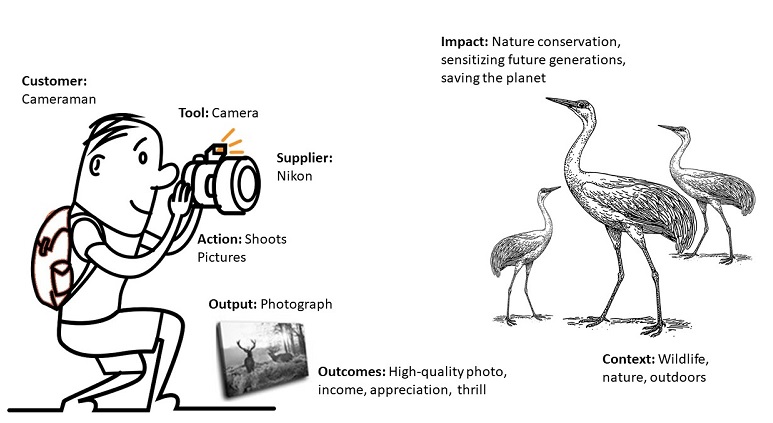Let us attempt to understand the various components of customer action. The image shows a man with a camera. He likes to use his Nikon D500 to capture wildlife photographs during his travels to various exotic places. He showcases the photographs on his website and regularly writes blogs about his adventures. He also sells some of his prized photographs through auctions at exhibitions and donates them to various charities. He has a regular job, and photography is his hobby. He shares his experiences during his talks with students in schools and colleges and highlights the need to save and protect the planet and its diversity.

The act of taking photographs can be broken down into various elements such as the context (wildlife settings), customer (photographer), tool used (camera), action (taking photographs), outcome (photograph, travelogues, exhibitions, income generation, recognition), and impact (saving the planet, influencing future generations). And yes, the camera was sold by a supplier! These elements are present in every action executed by any customer. Customer value can be discovered by studying the various elements of the job-to-be-done. Nouns represent these seven elements – context, customer, tools, actions, outcomes, impact, and supplier – and are called value nodes.
The cameraman is expected to be motivated to take photographs, have skills to operate the camera, have resources to buy the camera, have high expectations of his abilities to take high-quality photographs, and be passionate about photography. Having financial resources to purchase a camera and being aware of the positive benefits of the outcomes and the impact may still not be good enough for the customer to buy the camera if he does not have the skills to operate a camera or finds photography not exciting enough or believes that this activity is not aligned to his personality. The presence of elements such as appropriate skills, high levels of motivation, financial resources, enabling beliefs, and resourceful emotions is likely to speed up the decision to purchase the camera and realise value for the customer. These elements are like catalysts that increase the rate of a chemical reaction and are referred to as value catalysts. Value catalysts provide the impetus to act. Their enabling presence can speed up the customer’s decision to purchase the tool. If the camera supplier organises free classes to enhance relevant skills or convenes meetings with photographers that focus on the pleasures of wildlife photography or offers free membership to a club that organises wildlife tours, this is likely to influence a set of potential customers to buy the product. Customer value resides in each of these nodes and catalysts. These nodes and catalysts are part of the customer-action-cycle (CAC) model as described in part 2.
The CAC model is simple and at the same time captures all the elements associated with discovering value in an elegant and logical way. The relationship between the value nodes is represented by verbs. The sum of all these relationships constitutes the overall customer experience. It may be noted that the supplier value node is outside the Customer-Action Cycle but contributes to customer value. If the customer has a choice of multiple offerings that provide similar value, the differentiating factor that is likely to influence the customer’s decision is supplier perception and relationships.
A deep analysis of the CAC model results in a tool called the Value Discovery Canvas which is part of my upcoming book on Customer Value.





